#adult dog food
Explore tagged Tumblr posts
Text
When to Stop Feeding Your Dog Puppy Food
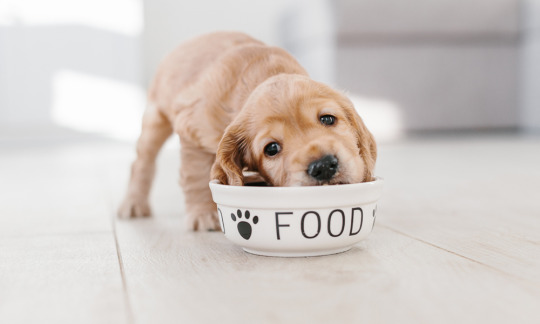
Proper nutrition is an important part of caring for puppies and adult dogs. Most owners know that puppies need food specifically made to promote growth and development. However, many owners struggle to determine when the time is right to switch to adult dog food. This is because there is no rule that applies to all dogs. Different dogs grow at different rates. You and your vet can estimate the best time to make the change to your puppy's diet
Feeding Puppy Food
Puppies need more calories than adult dogs to support their growth, development, and high energy levels. Young puppies need about twice the number of calories as adult dogs of the same size. As your puppy approaches adulthood, his growth begins to slow and his caloric needs decrease. If you continue to feed puppy food once your dog stops growing, it will result in weight gain. Excess weight can quickly turn into obesity, which can lead to a host of health problems.
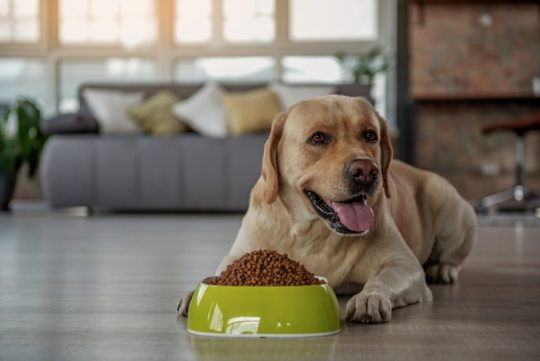
When to Switch to Adult Food
In general, dogs are considered puppies until about one year of age. However, different breeds age at different rates. For example, many large and giant breed dogs are considered puppies until two or more years of age and will therefore need to remain on puppy food beyond age one. Conversely, some small dog breeds reach adult size before the age of one. Your veterinarian is the best source of information when it comes to your dog's diet, so ask for advice before making the switch to adult food.
When deciding on the right time to feed adult dog food, the goal is to switch to adult food around the time the puppy stops growing but before he starts gaining excess weight. Keep track of your puppy's weight and height and look for the numbers to increase at a slower rate. Most dogs will begin to reach a plateau around one year of age, but you might notice the growth slow down as early as eight or nine months of age.

Assessing Your Dog's Weight
Be aware that weight gain does not necessarily indicate growth. If your dog is gaining weight but not getting taller or more muscular, he may be getting overweight. You can address your dog's body condition at home in a few steps:
Run your hands along your dog's ribcage. You should be able to feel the ribs covered by a thin layer of fat. If you cannot easily feel the ribs, your dog may be overweight.
Look at your dog from the side. You should be able to see the upward tuck of the belly. An overweight dog will have very little or no tuck.
View your dog from above. There should be some narrowing at the waist just past the ribcage. A straight or bulging line from the ribcage to the hips indicates an overweight dog.
Very prominent ribs and a very small waist may mean your dog is underweight. Visit your vet for an exam to be sure.
If your dog is less than a year old and seems to be gaining weight, you may need to simply reduce the portion size or frequency of meals before you switch to adult food. Vets recommend feeding young puppies three times per day. However, most puppies can go down to meals a day when they are approaching adulthood.
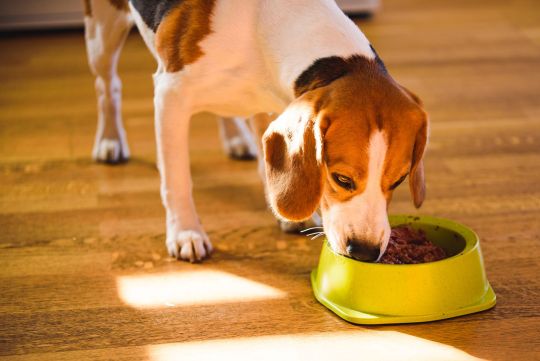
How to Make the Diet Change
Any diet change should be done gradually to avoid gastrointestinal upset. This process can take a week or two depending on how you do it.
It may take some time and research to choose the right food for your now-adult dog. You may wish to stick with the same brand of food but switch to an adult formula. Of course, your vet can help you find an appropriate diet.
Once you have chosen the adult dog food, determine the portion size of adult food you will eventually need to feed based on your dog's current weight. Then, add a small percentage of adult food to the puppy food, increasing it a little at each meal. For simplicity, you may want to work out a schedule so you are not trying to remember how much of each to feed. Many veterinary professionals recommend the "3 by 3" approach when switching diets:
Days 1-3: Feed 1/3 portion of adult food and 2/3 portion of puppy food
Days 4-6: Feed 1/2 portion of adult food and 1/2 portion of puppy food
Days 7-9: Feed 2/3 portion of adult food and 1/3 portion of puppy food
Day 10 and on: Feed full portion of adult food
During the switch, watch your dog's appetite and bowel movements. Slow the transition if your dog experiences diarrhea or vomiting. If GI upset continues, you may need to choose a different adult diet and re-start the transition. Contact your vet if your dog has vomiting or diarrhea for more than a day.
Watch your dog's weight over the coming months to make sure you don't need to adjust portion times. Also, be sure to keep up with annual or biannual veterinary wellness check-ups as recommended by your vet.
13 notes
·
View notes
Text
Should You Add Goat Milk to Your Dog’s Diet?
Thinking about leveling up your pup’s mealtime? Adding goat milk for dogs might just be the secret ingredient you’re looking for! It’s not just a trend — goat milk is packed with probiotics, vitamins, and easy-to-digest nutrients that can support your dog’s gut health and boost their overall wellness.
Whether your furry friend prefers wet dog food or dry dog food, a splash of goat milk can make mealtime more exciting and nutritious. It’s a great option for all dogs — from playful pups to senior companions — helping to keep their digestion smooth and their immune system strong.
If you're hunting for the best dog food options or looking to create a more healthy dog food plan, goat milk can be a natural addition. It’s gentle on sensitive stomachs and pairs perfectly with adult dog food or wet food for an extra nutrient kick.
So, should you add goat milk to your dog’s diet? Absolutely! It’s simple, healthy, and a pawsome way to show your dog some extra love.
For more information, visit us at www.hyefoods.com
#dog food#best dog food#healthy dog food#adult dog food#wet food#Senior dog food#dog nutrition#puppy treats#dog kibble#dog food recipe#fresh dog food#raw dog food#best fresh dog food#homemade dog food#food for dogs#dog food online#dog food for allergies#diet dog food#healthy dog treats#natural dog treats
0 notes
Text
Give your senior toy & small breed dog the nutrition they deserve with our premium Senior Dog Food, specifically crafted for their unique dietary needs. Packed with high-quality ingredients, including dried yeast, green peas, chickpeas, and flaxseeds, this formula is rich in essential amino acids similar to those found in animal proteins like chicken.
0 notes
Text
Premium Dog Food - Healthy, Natural, and Nutritious Meals | Bark Out Loud
0 notes
Text
5 Reasons Blue Buffalo Life Protection Formula Adult Dry Dog Food is the Best Choice for Your Dog's Nutrition
Choosing the right food for your dog is crucial for their overall health and well-being. Blue Buffalo Life Protection Formula Adult Dry Dog Food offers a premium blend of high-quality proteins, wholesome grains, and essential nutrients designed to support your dog’s health at every life stage. Packed with real meat, fruits, and vegetables, this formula provides balanced nutrition that helps keep…
0 notes
Text
Understanding the Nutritional Needs of Adult Dogs: A Comprehensive Guide
Introduction: Providing proper nutrition is essential for ensuring the health and well-being of your adult dog. Understanding their unique nutritional needs is crucial for selecting the right food to support their overall health. In this comprehensive guide, we'll delve into the key aspects of adult dog food to help you make informed decisions about your furry friend's diet.
Essential Nutrients for Adult Dogs:
Protein: The Foundation of a Healthy Diet - Learn why protein is vital for adult dogs, its role in muscle maintenance, and how to choose high-quality protein sources.
Carbohydrates: Energy Source and Fiber - Explore the role of carbohydrates in providing energy and promoting digestive health in adult dogs.
Fats: Essential for Vital Functions - Understand the importance of dietary fats for adult dogs, including their role in nutrient absorption and skin and coat health.
Vitamins and Minerals: Supporting Overall Health - Discover the essential vitamins and minerals needed to maintain your adult dog's immune system, bone health, and more.
Understanding Your Dog's Individual Needs:
Breed, Size, and Activity Level - Learn how factors such as breed size and activity level influence your dog's nutritional requirements and how to tailor their diet accordingly.
Health Considerations - Understand how certain health conditions, such as allergies, joint issues, or obesity, may impact your dog's dietary needs and how to address them with specialized nutrition.
Reading Dog Food Labels:
Deciphering Ingredients Lists - Learn how to interpret dog food labels and understand common ingredients, including protein sources, carbohydrates, fats, and additives.
Identifying High-Quality Foods - Discover what to look for (and what to avoid) when selecting commercial dog foods to ensure they meet your dog's nutritional needs.
Transitioning to a New Food:
Gradual Transitioning - Understand the importance of gradually transitioning your dog to a new food to avoid digestive upset and tips for making the transition smooth and successful.
Consulting with Your Veterinarian:
Importance of Veterinary Guidance - Learn why it's essential to consult with your veterinarian to determine the best diet for your adult dog, especially if they have specific health concerns or dietary needs.
Conclusion: Understanding the nutritional needs of your adult dog is key to providing them with a balanced and healthy diet. By considering factors such as protein, carbohydrates, fats, vitamins, minerals, individual needs, reading dog food labels, transitioning to new food, and consulting with your veterinarian, you can ensure that your furry companion receives the nutrition they need to thrive throughout their adult years.
0 notes
Text
https://pranav.lipsstudent.xyz/dogs/buy-royal-canin-dog-food/
1 note
·
View note
Text

Vet Recommended Dog Food Toppers for Picky Eaters
#dog food#adult dog food#Best dog food#Healthy dog food#Grain-free dog food#Natural dog food#Premium dog food#Organic dog food#Puppy food#Senior dog food
0 notes
Text
you can't treat fantasy race relations like they'd be exactly the same as real life race relations, because in real life humans are all fundamentally the same as each other, but in fantasy settings the 'races' are actual different species with real and objective and often very significant differences between them
to understand elf racism, the question you need to be asking isn't 'what makes them think they're so much better than humans?' but 'if dogs were sapient, how would you feel about them holding office?
#what if they wanted to go to college?#most dogs die before the age humans would usually be ready to start higher education#of course a dog is an adult by two years old but-- would it even be possible for them to learn as much as they'd need to in that time?#would you trust a dog surgeon?#they're going to have completely different food and music preferences because their literal senses are different#they're not going to appreciate some of our art the same way we do because their color vision is completely different#of course you can be friends with one but-- could you bring yourself to marry one? knowing they'll only live maybe another decade?#worldbuilding
73 notes
·
View notes
Text
The other day I was at therapy and my therapist was telling me about how she and my psychiatrist were talking about the possibility of me being autistic, and I told my therapist that I found it very funny bc my psychiatrist told me about it after i compared myself to a cat (i only like physical affection when i start it), and i have this joke that all cats are autistic and all dogs have adhd, and SHE LAUGHED AND SAID IT WAS A GOOD JOKE
Anyways I win therapy where's my star
#neurodivergent#autism#adhd#audhd#actually autistic?#idk man i thought it was just anxiety and adhd lol#but hey at least my psychiatrist knew a place where they diagnose adults so that's cool :D#and my cat is 100% autistic i'm so sorry#he only likes four foods and only if they are on his plate#he wont eat otherwise#once we changed his food and he decided to only eat the dog's food cause he didn't like it#so we had to change it back cause he wasnt letting the dog eat
13 notes
·
View notes
Text
How Can I Make Sure My Dog’s Food Is Nutritious and Balanced?
Every pet parent wants their furry friend to live a happy, healthy life — and that starts with feeding them the right dog food. But with so many options out there, how do you really know if your dog's meals are ticking all the right boxes? Let’s dive into how to make sure your pup's food is both nutritious and balanced.

What Makes Dog Food Nutritious and Balanced?
A well-balanced dog food should provide the right mix of:
High-quality protein: Supports muscle development and energy.
Healthy fats: Keep their coat shiny and skin healthy.
Fiber and complex carbs: Aid digestion and maintain energy levels.
Vitamins and minerals: Boost immunity and support overall dog nutrition.
Probiotics for dogs: Help balance gut bacteria for better digestion and health.
Choosing the Right Dog Food for Every Life Stage
Dogs have different nutritional needs depending on their age, so picking the right food matters:
1. Puppy Food
Growing pups need extra protein, calcium, and healthy fats. When feeding puppies, consider adding goat milk for dogs to support their digestion and give them a nutrient boost.
2. Adult Dog Food
For active adults, choose a healthy dog food with a balanced mix of protein, carbs, and fats. Mixing wet dog food and dry dog food can keep meals exciting and hydrating.
3. Senior Dog Food
As dogs age, they may need fewer calories but more joint support. Look for senior dog food with added omega-3s, fiber, and probiotics for dogs to support their aging bodies.
Adding Extra Nutrition: Probiotics and Goat Milk
Beyond regular meals, you can boost your dog’s health with these simple additions:
Probiotics for dogs: These improve digestion, strengthen immunity, and balance gut health.
Goat milk for dogs: A nutrient-dense topper packed with vitamins, probiotics, and easily digestible proteins. Perfect for sensitive stomachs!
Tips to Ensure Your Dog's Food is Truly Balanced
Read the label: Look for whole ingredients like real meat, fish, veggies, and healthy grains.
Avoid fillers: Steer clear of foods heavy in corn, wheat, or soy — they offer little nutritional value.
Mix it up: Combine wet food with dry dog food to balance hydration and crunch.
Include healthy treats: Puppy treats and dog treats should complement their meals, not replace them.
Consult your vet: Always check with your vet to tailor your dog's diet to their specific needs.
Final Thoughts
Ensuring your dog’s food is nutritious and balanced doesn’t have to be complicated. Focus on high-quality dog food, add in beneficial extras like probiotics for dogs and goat milk for dogs, and match their diet to their life stage — whether that's puppy food, adult dog food, or senior dog food.
At the end of the day, a well-fed pup is a happy, healthy pup. So let’s keep those tails wagging with the best nutrition possible!
Read more related articles:
How Pet Food Can Impact Your Dog’s Skin and Coat Health
The Benefits of High-Protein Dog Food for Active Breeds
What’s The Best Dog Food for Puppies and Growing Dogs?
How to Read Cat and Dog Food Labels: What Matters Most?
Cracking the Kibble Code: Finding your Cat’s Inner Foodie with the Purrfect Diet
A Comprehensive Overview on Goat Milk for Dogs: Health Benefits, Risks, and Practical Tips
Delicious Goat Milk Watermelon Popsicles
How Your Dog’s Diet Affects Their Skin: Let’s Talk About Dog Food and Skin Allergies
Care for your Aging Dog — Wagging mustn’t stop in their Golden years!
Our Pet food Products:
Goat Milk Powder with Probiotics
Goat Milk Powder for Dogs and Cats
Camel Milk Powder for Dogs and Cats
#dog food#best dog food#healthy dog food#adult dog food#wet food#Senior dog food#dog nutrition#puppy treats#dog kibble#puppy kibble#feeding puppies#dog treats#puppy food#dog feeding#dog food recipe#fresh dog food#raw dog food#best fresh dog food#homemade dog food#dog food online#dog food for allergies#diet dog food#healthy dog treats
0 notes
Text
Give your medium and large-breed adult dogs the nutrition they deserve with NutriBoost Superfood Dog Meal. Carefully crafted with premium plant-based ingredients, this meal provides a wholesome and balanced diet.
0 notes
Text
Understanding the Difference Between Puppy Food and Adult Food - BOL
Choosing the right food for your dog's life stage is crucial for their overall health and wellbeing. In this blog, we'll delve into the differences between puppy food and adult food, and why selecting the appropriate food for dogs at each life stage is essential.
0 notes
Text
took me a minute to warm up to wobbledogs but now that i know you can produce a dog with, say, 27 legs and 10 heads i'm very into it. i just wish it wasn't a fucking "sit there and wait with no way to get around this" kind of game
#generally i am just cycling through litters of puppies from the simulator all at the same time and feeding them mutation 'foods'#but they are all slightly different ages so it feels a little chaotic#it is more chaotic with adults also there eating random food#so far i have double head a tail and spots#i would really like wings or horns though#would also be a fan of triple cerberus head but i might have gotten lucky with the two headed dog only a couple of hours in as well
22 notes
·
View notes
Text
Top-Rated Natural Dog Food – Blue Buffalo Life Protection -Product Reviews Customers

Product details
Brand: Blue Buffalo
Flavor: Chicken & Brown Rice
Age Range: Adult Dogs
Item Form: Kibble
Specific Uses: Immune Support
Item Details
Brand: Blue Buffalo
Flavor: Chicken & Brown Rice
Age Range: Adult Dogs
Item Form: Kibble
Special Ingredients: Antioxidants for Immune Support
Container Type: Bag
Breed Recommendation: Medium Breeds & All Breed Sizes
Perfect For: Birthdays & Special Treats
Allergen-Friendly: Wheat-Free, Corn-Free, Soy-Free, No Preservatives
Customer Favorite: ⭐ 4.6/5 Stars (50,833 Ratings)
Bestseller Rank: #1 in Dry Dog Food, #6 in Pet Supplies
Main Ingredients:
Deboned Chicken, Chicken Meal – High-quality protein for muscle support
Whole Grains: Brown Rice, Barley, Oatmeal – Provides essential energy
Healthy Additions:
Pea Starch, Flaxseed, Chicken Fat – Supports a healthy skin & coat.
Natural Flavor, Dried Tomato Pomace, Peas, Pea Protein, Salt, Potassium Chloride – Enhances taste & provides essential minerals.
Superfoods & Antioxidants:
Blueberries, Cranberries, Barley Grass, Parsley, Turmeric, Dried Kelp, – Boosts immune health
Sweet Potatoes, Carrots, Garlic, Vegetable Juice for Color – Rich in vitamins and fiber
Digestive & Joint Health:
Direct Dehydrated Alfalfa Pellets, Dried Chicory Root, Potatoes, Pea Fiber, Alfalfa Nutrient Concentrate – Aids digestion & gut health
Glucosamine Hydrochloride, Calcium Carbonate, Choline Chloride, DL-Methionine – Supports strong joints & mobility
Essential Vitamins & minerals:
Vitamin E, Vitamin C, B-Complex , Vitamin D3, Vitamin A – Complete nutritional balance
Zinc Amino Acid Chelate, Zinc Sulfate, Ferrous Sulfate, Iron Amino Acid Chelate, Copper Sulfate, Copper Amino Acid Chelate, Manganese Sulfate, Manganese Amino Acid Chelate, Calcium Iodate, Sodium Selenite – Vital minerals for overall health
Probiotics & Natural Preservatives:
Dried Yeast, Dried Enterococcus faecium, Dried Lactobacillus acidophilus, Dried Bacillus subtilis – Promotes healthy digestion & gut flora
Oil of Rosemary, Preserved with Mixed Tocopherols – Natural preservatives to maintain freshness
About this item
REAL CHICKEN FIRST – High-quality deboned chicken for strong muscles.
WHOLESOME ING REDIENTS– Brown rice, cranberries & veggies for balanced nutrition.
NO FILLERS OR BY-PRODUCTS – No poultry by-products, corn, wheat, or soy.
OPTIMAL NUTRITION – Essential proteins, carbs & Omega-3 & 6 for a healthy coat.
IMMUNE SUPPORT – Includes Life Source Bits packed with antioxidants, vitamins & minerals
LARGE 34-lb. BAG – Perfect for keeping your pup happy & healthy.
Read More Click Buy From Amazon>>
⭐Blue Buffalo Life Protection-Product Reviews Customers
1. Freddy says I am ready, for the more of that blue buffalo, don’t you know?
My best friend, really enjoys this. That manners the most. But the ingredients also! I feel good about feeding this to him. It’s reasonably priced. I am very happy with the product. Most importantly Freddy is.
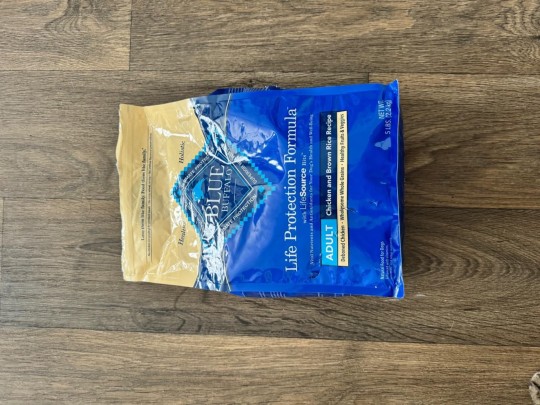
2.Picky Eater Loves it
Love Blue buffalo Food! High quality ingredients, along with great resealable packaging. Even the cat tried to eat the food thru the bag! 5lbs is just what was needed to make the transition to adult food. Was packaged perfectly and the best by date was over a year out.I have a Mini schnauzer named Bunnie, adopted at 8 weeks from a local rescue, has been a picky eater since day one in her new home. We tried the puppy food recommend from the rescue with no luck, the cute thing wouldn't eat out of a dog bowl either.After a lot of research into bags of dog food found that blue buffalo was highly rated and had an ingredient list that was wholesome. Bunnie tried the Blue Buffalo Puppy Chicken and Rice and she love it! Finally a food she enjoyed with the small triangle pieces and great taste has encouraged her to grown big and forward to a year and now and she has grown up to her full size of 16lb. We are making the Switch to the Blue Buffalo Adult Chicken and Rice Food and Bunnie loves the bigger sized triange pieces along with the same great flavor. She had an easy transition from puppy food to adult food, mixed properly throughout a couple weeks of her feeding. No tummy upsets and she is more eager than ever for her breakfast and Dinner. One Happy Pup!

3.Always a winner dog food
I've always trusted this brand. Mixed with their wet dog food is a treat for my dogs every time! I love add pumpkin powder, berries, and chopped up carrots for extra antioxidants and vitamins. Annnnnd I always subscribe to pet products because I get a discount + never have to worry about running out!
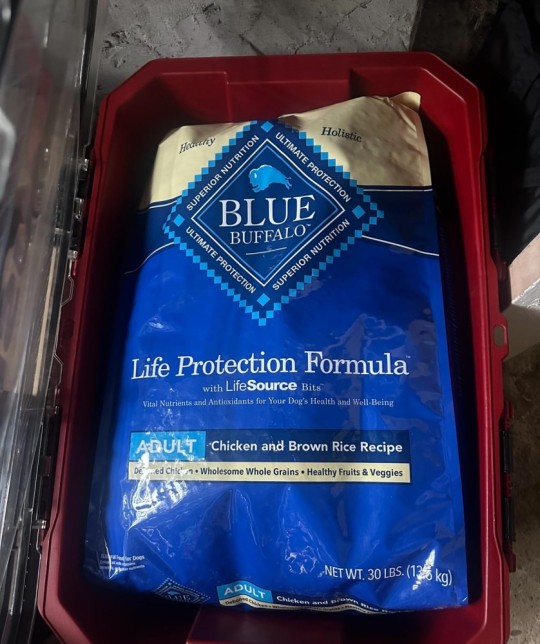
4.Quality ingredients
Great quality and the dogs love it. I made homemade fresh food for a year and they are happier and healthier after switching to blue Buffalo.

#blue buffalo#blue buffalo life protection#blue buffalo life protection formula#blue buffalo dog food#blue buffalo life protection dog food#life protection formula#blue buffalo life protection small breed#blue buffalo life protection puppy#blue buffalo life protection recall#dog food blue buffalo#blue buffalo life protection review#blue buffalo life protection formula natural adult dry dog food#blue buffalo dog food review
3 notes
·
View notes
Note
Imagine you have to set up yakumo's enclosure for the next couple months. How do you set it up and what do you put in there?
oh NO.! THE PROPPHECY HAS BEenm FUFILLED

i am standing in my room, leggies rooted to the floor. i am in shock .frozen and i have no idea how to proceed. there is a perpetual pathetically sobbing serpent under my blankie.
#stares at the camera and stage whispers#i can't be responsible for another living creature. i can't. or . er. i can. but I SHOULDN'T#i'll have to suppress every violent urge in my body to keep this thing alive for several months#i CANNOT fling him out the window. i WILL NOT grab his entire face and squeeze. I SHALL NOT chew on his tail.#now i'm reminded of that post where it's a pretty princess cage on the floor and comments go [that aint big enough for a dog]#and OP is all [it's not FOR a dog 😀]#yeah. that's me right now imagining a full grown yakumo in a cage by my bedside#SO FOR EASE OF MY IMAGINATION AND TO increase yaku's chance of surviving these next months#i'm going to try real hard to imagine him exclusively in pocket snake form (scrunches up my face in valiant effort)#his enclosure (crib?!?!) is flanked on all sides by eiden plushies#since yaku is an adult there is a smaller chance of him suffocating on eiden in his sleep. wait. actually#arranges the eiden walls to give some pockets of air. i don't trust him. he WILL suffocate on eiden given the opportunity#he gets one of those tiny dollhouse cooking sets for enrichment LOL#or i'll give him a bunch of those make-your-own gummy kits with elaborate setups and tiny egg gummies#crying yaku is the excuse i need to finally get a humidifier#i can survive not misting myself.. usually... but yaku will cry himself into dehydration. it's misting time#he gets an entire alcove closed off in the corner with his basic needs met. i cannot perceive#he can lurk in privacy as much as he wants. there are at least TWO hot rocks in there with garukaru's faces painted on em#there is a duplicate open-space alcove next to it for when he actually wants something from me LOL#is he a free range snake? can i take him to a bunch of restaurants and shove food into my sleeve for him? he wants to sample the delights..#tempted to put a bell on him just so if he gets loose in the basement i'll know to fish him out#but he's pretty cautious... he won't get into any fatal situations in the house right? ...does he know how to swim?!#at least one day is reserved for testing yaku's swimming capabilities.#he is going into the bathtub while it has a film of water. gonna test his traction. i hope i won't get panic-strangled#asks
19 notes
·
View notes